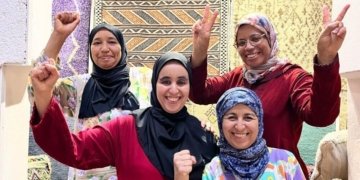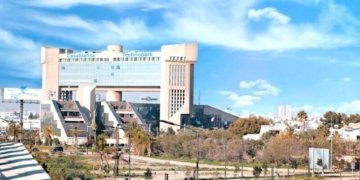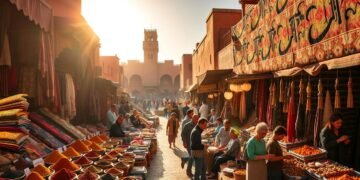Have you ever wandered through a city where time stands still? Step into the UNESCO World Heritage site of Fes, a place where history breathes through every alleyway. Founded in 789 CE, this ancient city remains Morocco’s spiritual and cultural heartbeat.
Recognized for its preserved medieval architecture, Fes is the largest car-free urban zone in the world. Its labyrinthine streets hide centuries-old traditions, from vibrant souks to the iconic Chouara Tannery. Nestled near the Atlas Mountains, this city blends history with living culture.
Designated a World Heritage Site in 1981, Fes captivates visitors with its timeless charm. The Al Quaraouiyine University, the oldest in the world, stands as a testament to its intellectual legacy. Discover why this city is often called the “Mecca of the West.”
Key Takeaways
- Fes is Morocco’s cultural and spiritual capital, founded in the 9th century.
- It’s a UNESCO-listed site, celebrated for its medieval urban fabric.
- The city is the world’s largest car-free urban zone.
- Home to the oldest university, Al Quaraouiyine.
- Famous for its bustling souks and historic Chouara Tannery.
Introduction to the Medina of Fes
Few places capture the essence of medieval life like this UNESCO gem. With over 9,400 preserved buildings, the labyrinthine alleys transport visitors to another era. The air hums with the scent of spices and the sound of artisans at work.
Why This Ancient City Is a Must-Visit
At its core lies Al-Qarawiyyin University, founded in 857 CE. Recognized as the world’s oldest degree-granting institution, it symbolizes Fes’ intellectual legacy. Nearby, the Chouara Tannery’s 11th-century vats showcase unchanged leather-dyeing techniques.
What Makes It a UNESCO World Heritage Site
UNESCO honors the city for two criteria: urban continuity (iii) and Islamic architecture (iv). The medina’s layout reflects a seamless blend of function and artistry. Just beyond its walls, the Ville Nouvelle district offers a stark modern contrast.
The Rich History of the Medina of Fes
Centuries of history unfold in Morocco’s ancient capital. Founded in the 9th century, this city became a cultural powerhouse under successive dynasties. Its legacy is etched into every alley and monument.
Founding and the Idrisid Dynasty
Idris II established Fes as the country’s capital in 809 CE. He united two settlements—Madinat Fas and al-ʿĀliyá—laying the groundwork for the medina. By the 11th century, Almoravid rulers, fortified its role as a trade and learning hub.
Golden Age Under the Marinids
The 14th century marked a peak under the Marinids. They built Fes Jdid, adding seven madrasas, including the Bou Inania. The Chouara Tannery thrived, showcasing techniques still used today.
From Saadis to Modern Day
In the 16th century, the Saadis erected Borj Nord to guard the city. The Jewish Mellah, founded earlier, became a vibrant district. Modern efforts preserve these layers of history against urban change.
Exploring Fes el Bali: The Old Medina
Step into a living museum where every corner tells a story. This ancient town, spanning 540 acres, is a masterpiece of urban design. Its 9,500 alleys weave through historic buildings, creating the world’s largest car-free urban area.
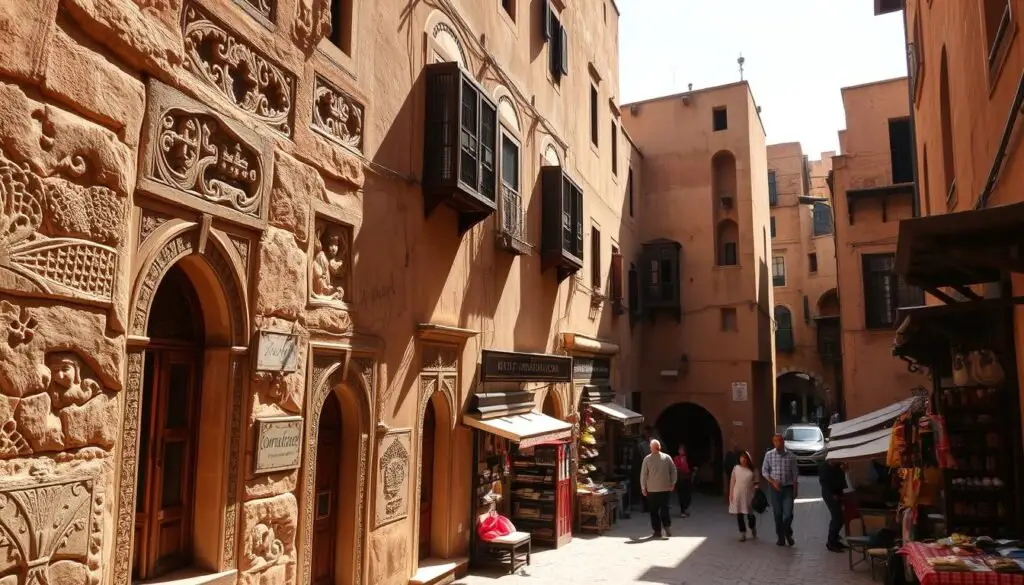
Architectural Marvels of the Ancient City
Bab Bou Jeloud, the iconic blue gate, welcomes visitors with its 1913 mosaic restoration. Behind it lie remnants of the original 12th-century structure. The 11th-century water system, including hidden qanats, still functions today—a testament to Dunas ibn Hamama’s engineering genius.
The Labyrinthine Streets and Their Secrets
Navigating the streets here is an adventure. Donkey-wide paths branch off main thoroughfares, designed for pedestrians and pack animals. Rooftop gardens and underground channels hide in plain sight. GPS often fails in this maze—locals recommend hiring a guide.
Fourteen historic gates mark entry points, each with its own story. The sheer size of the maze ensures surprises at every turn. From hidden courtyards to bustling souks, the area thrives as a living relic of medieval life.
Key Landmarks in the Medina of Fes
Discover where scholarship, artistry, and tradition converge. These landmarks preserve Morocco’s legacy, from ancient learning centers to vibrant craft hubs. Each site offers a window into centuries of cultural evolution.
Al-Qarawiyyin Mosque and University
Founded in 859 CE, this complex blends spiritual and academic life. Its mosque remains a sacred space, while the attached university holds 4,000 rare manuscripts. Non-Muslims can explore the library, though prayer areas have restricted access.
The world’s oldest degree-granting institution, it shaped Islamic scholarship. Its arched courtyards and cedarwood shelves echo with intellectual history. Scholars once debated philosophy here under flickering lantern light.
Bou Inania Madrasa: A Masterpiece of Islamic Art
This 14th-century school dazzles with geometric zellij tilework and Quranic calligraphy. Brass doors open to a courtyard framed by carved cedar screens. Every surface tells a story through intricate patterns.
Built by Sultan Abu Inan, it’s one of few madrasas with a minaret. The green-tiled roof glows at sunset. Visitors admire the harmony of math and spirituality in its design.
Chouara Tannery: A Glimpse into Traditional Craftsmanship
Watch artisans treat hides in stone vats using methods unchanged since the 11th century. Pigeon dung softens leather before vegetable dyes transform it into vibrant hues. Mint leaves help counter the pungent aroma.
Nearby, Dar Batha palace showcases woodcarvings from the same era. For the best photos, visit at dawn when the tannery’s rainbow pits catch the first light.
The Vibrant Souks of Fes
A kaleidoscope of colors and aromas awaits in the city’s legendary markets. These bustling lanes are the heartbeat of daily life, where generations of artisans trade goods unchanged for centuries. Each souk tells a story, from spice-scented alleys to the hum of copper being shaped by hand.
Souk Al-Attarine: The Spice Market
Step into a world where pyramids of cumin, turmeric, and ras el hanout rise like tiny mountains. Vendors proudly display saffron threads and argan oil, staples of Moroccan cuisine. The air is thick with scents—earthy, sweet, and pungent—all part of the market’s magic.
Friday transforms the scene. Rural farmers arrive with fresh herbs, doubling the market’s energy. Bargaining is expected; start at 30% of the asking price. Watch for family-run stalls—they often share stories behind their blends.
Souk el Henna: The Oldest Market
Dating to the 9th century, this market specializes in henna paste used for weddings and festivals. Artisans grind leaves into intricate designs, a ritual unchanged since the Idrisid era. Nearby, leatherworkers and coppersmiths occupy guild-zoned lanes, proof of the city’s organized trade legacy.
For travelers, these souks are a must for any trip. They offer more than goods—they’re a living museum of craft and community.
Cultural Significance of the Medina
The heartbeat of Morocco’s heritage pulses strongest in its ancient quarters. Fes remains the country’s cultural capital, where medieval crafts and spiritual rituals shape daily life. Here, history isn’t just preserved—it’s lived.
The Role of Fes in Moroccan Identity
Local people uphold centuries-old techniques, from leather dyeing to woodcarving. Apprentices still train in family workshops, passing down skills unchanged since the Idrisid era. The city’s traditions are a bridge between past and present.
At night, Sufi brotherhoods perform hadra ceremonies, chanting and dancing to honor divine love. These rituals, held in hidden zawiyas, reveal the city’s spiritual depth. Even Moulay Idriss II’s tomb draws pilgrims, though non-Muslims view its ornate entrance from afar.
Festivals and Traditions in the Medina
Annual festivals like the Fes Festival of World Sacred Music transform the streets. Gnawa musicians and Sufi choirs fill the air with hypnotic rhythms. The event, started in 1994, celebrates global spiritual harmony.
During Ramadan, the medina’s rhythm shifts. Streets buzz pre-dawn with vendors selling msemen (flatbread), then quieten for daytime fasting. At sunset, the call to prayer echoes as families gather for ftoor.
This city is a living testament to Morocco’s soul—where every alley whispers stories of faith, art, and resilience.
Practical Tips for Visiting the Medina of Fes
Smart planning makes exploring this ancient maze both rewarding and hassle-free. From ideal seasons to insider navigation tricks, these strategies help you experience the city’s magic without the stress.
Best Time to Visit
Spring (March-May) offers perfect 68°F days and fewer crowds. Summer brings intense heat, while winter discounts on lodging come with chilly evenings. For cooler temperatures and shorter lines, aim for pre-dawn starts—markets open early, and light is ideal for photography.
Key landmarks like blue-tiled fountains help with orientation. Pack comfortable shoes; you’ll walk miles on uneven stone paths. Hydration is crucial—carry a reusable bottle and refill at public fountains.
Navigating the Medina Like a Local
Licensed guides wear official badges—verify credentials to avoid scams. Reputable agencies like Fes Guided Tours offer vetted experts. Beware of overly “helpful” strangers who may demand payment for unsolicited directions.
Use Café Clock as a landmark. Offline maps are essential—GPS often fails in the narrow alleys. For solo exploring, note distinctive door knockers or mosaic patterns to retrace steps. Donkeys have right-of-way; press against walls when they pass.
Respect conservative dress codes, especially near religious sites. Evenings are lively but stick to well-lit main routes after dark. With these tips, you’ll navigate like a pro and uncover the city’s hidden layers.
Hidden Gems Off the Beaten Path
Beyond the well-trodden paths lie secrets waiting to be uncovered. While most visitors flock to famous landmarks, these quieter spots reveal the city’s authentic soul. From converted caravanserais to tucked-away courtyards, they offer respite from the bustling streets.
Funduq al-Najjariyyin: The Woodcarvers’ Inn
This 18th-century merchant inn now houses the Wood Arts Museum. Its cedar ceilings showcase intricate woodcarving techniques perfected over centuries. Don’t miss the rooftop terrace with panoramic views of the historic district.
Originally a resting place for traders, the building’s courtyard still bears witness to its past. Artisans demonstrate traditional tools, bringing Morocco’s craft heritage to life. The nearby Nejjarine Square fountain makes a perfect photo stop.
Dar Batha Museum: A Treasure Trove of Art
Once a 19th-century palace, this museum dazzles with Hispano-Moorish architecture. The central courtyard features zellige tilework framing a tranquil garden. Inside, Berber jewelry and antique astrolabes tell Morocco’s artistic story.
Sidi Ahmed Tijani Zawiya, just a short walk away, boasts lesser-known tile mosaics. For a break, try Café Clock’s rooftop—their camel burger is legendary. These quiet areas offer glimpses of daily life beyond the tourist trail.
The Medina of Fes as a Living Heritage Site
A living tapestry of tradition unfolds in this ancient quarter. Nearly 27,000 residents call these labyrinthine streets home, blending centuries-old customs with modern rhythms. From the clatter of copper workshops to the scent of freshly baked bread, the city pulses with daily life.
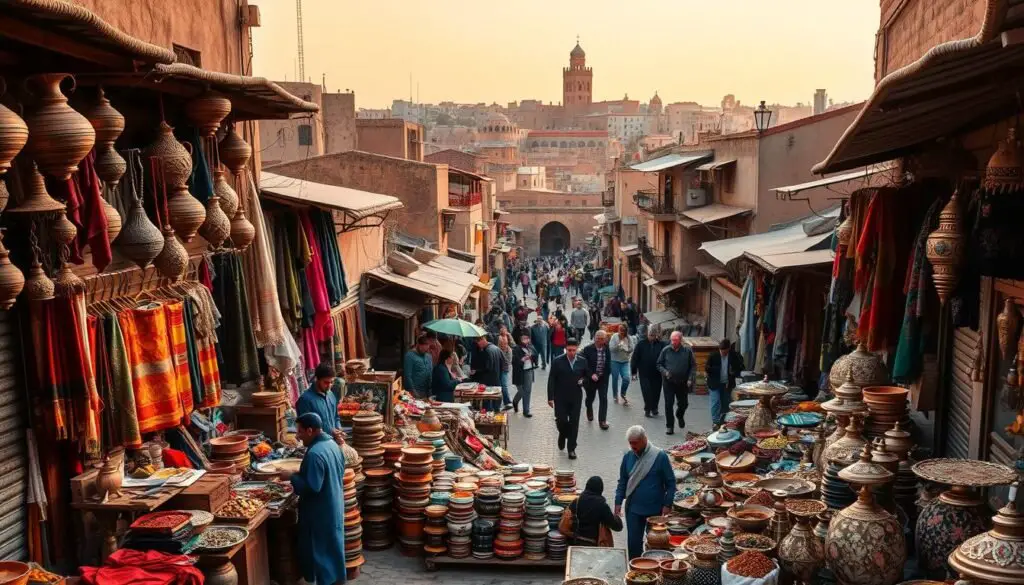
Daily Life in the Medina Today
Fifth-generation zellige tile cutters kneel in sunlit courtyards, chiseling geometric patterns unchanged since the Marinid era. Fridays slow to a quiet hum as locals rest, leaving alleys to echo with distant calls to prayer. The car-free lanes buzz with donkeys hauling goods—a living link to the past.
Solar panels now crown historic rooftops, powering homes without disrupting skyline silhouettes. Communal bakeries still fire clay ovens at dawn, while children dart past 11th-century fountains. This balance defines the medina’s soul: timeless yet adaptive.
Preservation Efforts and Challenges
ADER-Fes, the restoration agency, races against decay with 156 projects planned through 2028. Funding gaps threaten progress, as artisans juggle tourist demand with authentic techniques. “We guard our heritage like family heirlooms,” shares a woodcarver, his chisel tracing ancestral designs.
Tensions simmer between preservation and progress. Rising rents push out families, while souvenir shops multiply. Yet hope glimmers—a local imam champions solar-powered mosques, proving tradition and innovation can coexist. The medina’s challenges mirror its resilience: ever-evolving, never surrendering.
Comparing Fes to Other Moroccan Medinas
Morocco’s historic cities each tell a unique story, but none quite like this one. While Marrakech dazzles with vibrant performances, this UNESCO-listed gem offers quieter, deeper encounters with the country’s heritage. Three times larger than its famous counterpart, the labyrinth here feels more immersive.
Fes vs. Marrakech: A Cultural Contrast
Where Marrakech’s Jemaa el-Fnaa square thrills with snake charmers, this place whispers with scholarly tradition. The difference extends to craftsmanship—tanneries here operate openly, while Marrakech hides theirs. Only 4% of Morocco’s hotel capacity exists here, preserving local life.
The linguistic contrast surprises visitors too. Locals speak Fessi Arabic, distinct from other dialects. This linguistic fingerprint mirrors the city’s preserved identity. Artisans still use Marinid-era techniques, creating unbroken links to the past.
What Sets Fes Apart
Unlike Marrakech’s resort-lined outskirts, this area lacks large-scale tourism infrastructure. Its 60 historic fountains and car-free lanes maintain medieval authenticity. As Morocco’s spiritual capital, it prioritizes cultural preservation over commercial appeal.
While both cities hold UNESCO status, the experience here feels more intimate. The lack of crowds allows genuine interactions with copper-smiths and calligraphers. This isn’t a stage set—it’s living history unfolding daily.
Conclusion
This UNESCO-listed treasure remains Morocco’s beating heart, where ninth-century streets pulse with modern life. To truly absorb its layers, plan a minimum three-day trip—enough time to uncover hidden courtyards and artisan workshops.
Mark your calendar for 2025, when the city celebrates 40 years as a World Heritage site. Download official tourism apps for real-time navigation through its maze-like alleys.
As locals say, “This place mirrors Morocco’s soul.” From dawn prayers to twilight tannery visits, every moment here connects you to centuries of tradition. Pack curiosity, comfortable shoes, and let the adventure begin.
FAQ
Why is the Medina of Fes a UNESCO World Heritage Site?
The ancient city earned its UNESCO status due to its well-preserved medieval architecture, historic mosques, and vibrant cultural traditions. It remains one of the world’s largest urban car-free zones.
What is the best time to visit the Medina?
Spring (March-May) and fall (September-November) offer pleasant weather. Summers can be hot, while winters are mild but occasionally rainy.
How do I navigate the narrow streets without getting lost?
Hiring a local guide is highly recommended. Alternatively, use landmarks like Al-Qarawiyyin or follow the flow of people to main areas.
What are the must-see landmarks inside the Medina?
Don’t miss Al-Qarawiyyin Mosque, Bou Inania Madrasa, and Chouara Tannery. Each showcases unique craftsmanship and centuries-old traditions.
Is the Medina safe for tourists?
Yes, it’s generally safe. Stay aware of pickpockets in crowded markets and stick to well-lit streets after dark.
What makes Fes different from Marrakech?
Fes retains a more authentic, less touristy vibe. Its labyrinthine alleys and deep-rooted scholarly history set it apart from Marrakech’s bustling energy.
Can I visit the Chouara Tannery without a guide?
Yes, but guides often provide mint leaves to counter strong odors and explain the leather-making process in detail.
Are there modern amenities within the Medina?
While the streets feel timeless, guesthouses (riads) offer Wi-Fi and comforts. ATMs and pharmacies are available near main gates like Bab Bou Jeloud.







